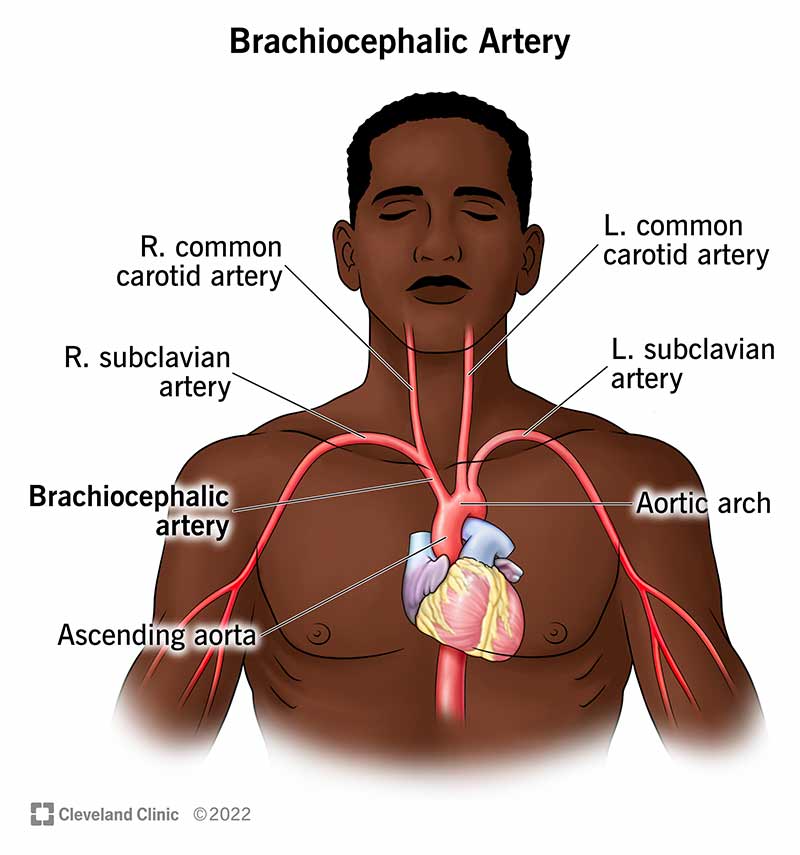Your brachiocephalic artery (trunk) is the first branch of your aortic arch. It’s also known as your innominate artery. It carries oxygenated blood to the upper right side of your body. Its two terminal branches are the right carotid artery (which sends blood to your brain) and your right subclavian artery (which sends blood to your right arm).
Advertisement
Cleveland Clinic is a non-profit academic medical center. Advertising on our site helps support our mission. We do not endorse non-Cleveland Clinic products or services. Policy

Your brachiocephalic artery is a blood vessel that branches off your aorta in your upper chest. It’s the first branch of your aortic arch, which is the curved, top part of your aorta that resembles the rounded handle of a cane. Your brachiocephalic artery helps supply blood to the upper right side of your body.
Advertisement
Cleveland Clinic is a non-profit academic medical center. Advertising on our site helps support our mission. We do not endorse non-Cleveland Clinic products or services. Policy
Other names for your brachiocephalic artery include:
Your brachiocephalic artery is part of your body’s circulatory system, which keeps blood moving throughout your body.
Your brachiocephalic artery helps oxygen-rich blood reach organs and tissues in your upper body. It’s responsible for carrying blood from your aorta to your right subclavian artery and right common carotid artery. This blood supplies oxygen and nutrients to your upper right arm and the right side of your brain, face and neck.
Your brachiocephalic artery carries oxygenated (oxygen-rich) blood. Your heart pumps oxygen-rich blood into your aorta. From there, this blood travels into your aorta’s many branches (including your brachiocephalic artery) to nourish your body.
Your brachiocephalic artery (trunk) is located in the upper right side of your chest, above your heart and below your neck. It’s in the part of your chest known as your mediastinum. This is an important space that holds your heart and many other structures, including parts of major blood vessels.
Your brachiocephalic artery is the first branch off your aortic arch. “First” means it’s the branch of your aortic arch that’s nearest to your heart. However, your brachiocephalic artery isn’t the first branch off your aorta overall. That’s because leading up to your aortic arch is your ascending aorta, or the part of your aorta that curves upward from your heart. Your coronary arteries branch from your ascending aorta and supply blood to your heart muscle. So, your coronary arteries are the first branches off your aorta.
Advertisement
Your brachiocephalic artery isn’t one of the great vessels of your heart and doesn’t directly connect with a chamber of your heart. Rather, it’s a branch of your aorta.
As it travels upward, away from your heart, your brachiocephalic artery divides (bifurcates) into two branches:
These are called terminal branches because your brachiocephalic artery ends at this point. The location of this division (bifurcation) is near an anatomical landmark called the right sternoclavicular joint. This is the spot on the right side of your body where your clavicle (collarbone) and sternum (breastbone) join together.
Your brachiocephalic artery (trunk) is generally 4 to 5 centimeters long. Its diameter ranges from 10.5 millimeters to 13.7 millimeters.
Like your other arteries, your brachiocephalic artery has walls made of three layers:
Because your brachiocephalic artery branches from your aortic arch, aortic arch variations can affect its anatomy. The most common aortic arch variation that affects your brachiocephalic artery is a two-vessel branching pattern.
Normally, three blood vessels branch directly from your aortic arch. These are your:
With a two-vessel branching pattern, only two arteries branch from your aortic arch, rather than three. Two such patterns include:
Most people only have one brachiocephalic artery, and it’s on the right side of their chest. However, some aortic arch variations may involve both a left and a right brachiocephalic artery, or just one on the left side.
Advertisement
Conditions that may affect your brachiocephalic artery include:
There’s a lot you can do to help keep all of your arteries healthy. Tips include:
Advertisement
Learning the anatomy of your arteries — and other parts of your circulatory system — can be both intimidating and exciting. Whether you’re learning more due to a medical condition or simply out of interest, don’t hesitate to reach out to a healthcare provider with questions. Anatomy is complex and isn’t necessarily the same in every person’s body. So, drawing upon your provider’s knowledge can fill in gaps as you read and help you see the big picture.
Advertisement
When your heart needs some help, the cardiology experts at Cleveland Clinic are here for you. We diagnose and treat the full spectrum of cardiovascular diseases.

Last reviewed on 11/02/2022.
Learn more about the Health Library and our editorial process.